
Outside the Golden Ring of Russia. Krasnoyarsk
/ Главная / Russkiy Mir Foundation / Publications / Outside the Golden Ring of Russia. KrasnoyarskOutside the Golden Ring of Russia. Krasnoyarsk
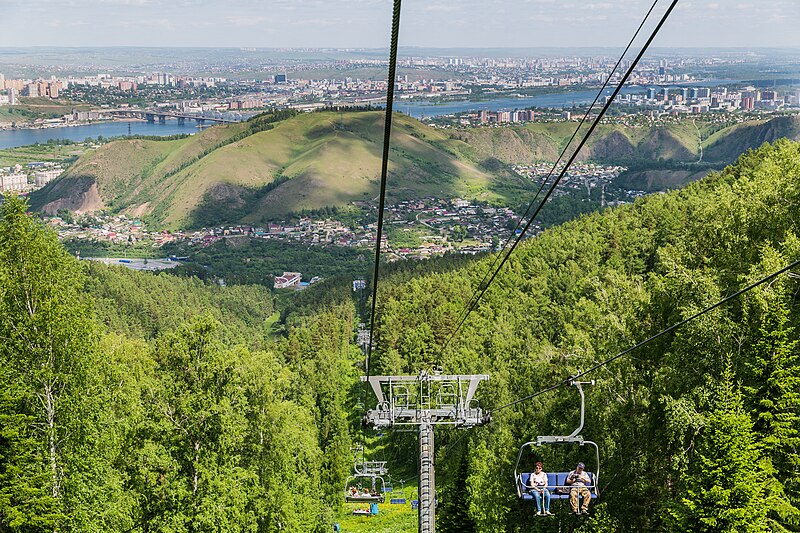
Beaver Log Fan Park and aerial cableway. Photo credit: Ninara / Wikimedia Commons
Krasnoyarsk feels like Florence in some ways. It can be admired from lovely observation decks on the hills. There is a picture-perfect river that divides the city, although the Yenisei is three times wider than the Arno. Beautiful natural surroundings literally embrace the residential areas. It takes up to thirty minutes to reach the ski slopes. When locals are asked, "Where is the taiga?", they smile and point to the nearby woods.
Right in the Heart of Russia
At times, if you want to discover something new, it takes a finger poking at a map and buying the last tickets for a train that travels along the Trans-Siberian Railway Network. What will be the destination? Vladivostok? It's too far. Kazan? Too close. Krasnoyarsk seems to be the perfect choice. Almost three days to reach it is just the right time to realize that our beautiful country is so big.
Our extended family members were waiting for us at the train station. We were welcomed so warmly that I immediately ceased figuring out the family tree branches that we had in common.
After warm hugs, we were immediately taken to the city center. We drove along the central street, Mira Avenue. It could be called "Little Moscow". The avenue along with several parallel streets was planned at the beginning of the nineteenth century. The design was based on the linear layout of the St. Petersburg type. The avenue was first known as Bolshaya Street, then as Voskresenskaya Street. After the revolution, it became Sovetskaya Street and was renamed Stalin Avenue in 1937. And finally, in 1961, it got its current name.
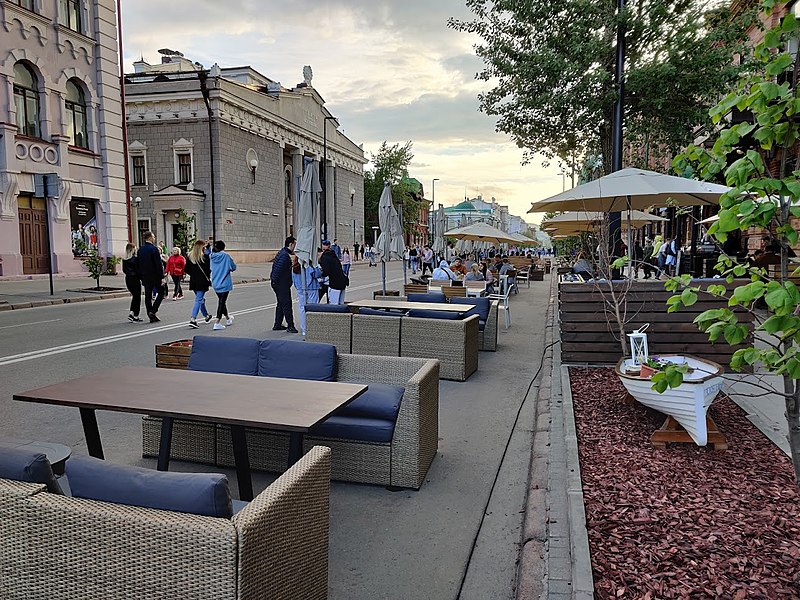
Krasnoyarsk historical center. Photo credit: Ilbudka / Wikimedia Commons
This sequence of renaming suggests that the street has always been the central one of the city. Wealthy merchants used to build their mansions on it. The building of the Noble Assembly was also located there. Today, all those buildings are intact, including the House of Officers, several theaters, and the unique Pharmacy of the Medical Society, which this year celebrated its 127th anniversary. Repeated restoration works have helped to preserve the building and furniture of Pharmacy No. 1 in their original condition. Furthermore, when a polite and attentive pharmacist offered a cough mixture in a tall glass jar, we imagined that their containers had not changed since then, either.
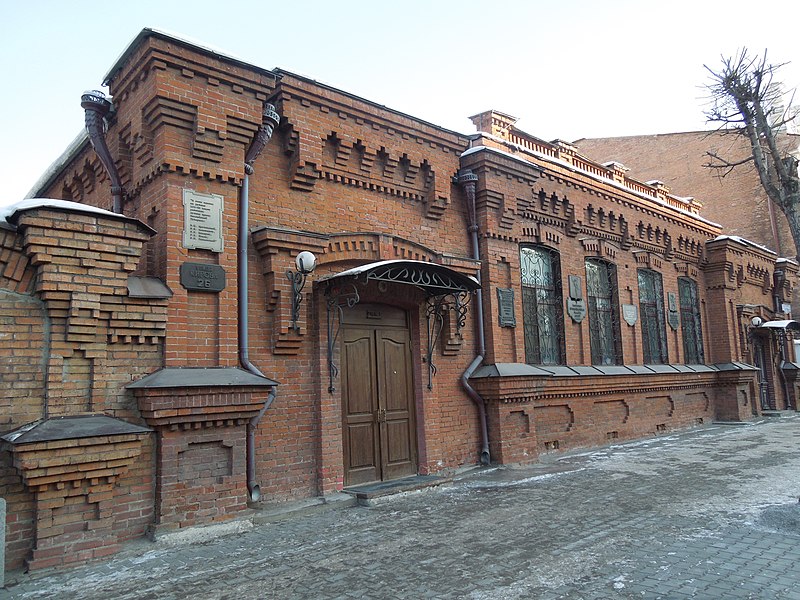
Hospital and pharmacy of the Medical Society. Photo credit: Masha Linnik / Wikimedia Commons
The city was founded in 1628. It was named "Krasniy Yar", which means "Beautiful Riverside" in modern language. It is located in the very heart of Russia, which is not an exaggeration. The geographical center of Russia is situated near Lake Vivi in the Krasnoyarsk Region. Those who wish to see this lake of extraordinary beauty need to book a special tour. As for us, let's get back to civilization.
It is the seventh most populated city in Russia with more than one million residents. The adjacent settlements are the homes of more than one and a half million people. Krasnoyarsk can rightfully be described as one of the most important economic centers of Siberia. Thus, it is more than a place where people enjoy living. In fact, entire companies have relocated here as well. The city hosts headquarters of such enterprises as Norilsk Nickel, RusHydro (the largest energy holding), Polyus Gold (the leader of the Russian gold mining industry), and many others.
It is also home to major scientific, educational, and sports centers, and the city has a total of more than one hundred and fifty thousand students. There is the Siberian Federal University, the Scientific Center of the Siberian Branch of the Russian Academy of Sciences, the Krasnoyarsk Region Innovation and Technology Business Incubator, the Biathlon Academy and the Academy of Winter Sports, the Federal Center for the Development of Rugby in Siberia and the Far East...
History and Culture
Every history page is honored on the city map. First of all, almost all architectural monuments in the city center have been refurbished and equipped with plaques describing their history in detail. Buildings associated with such prominent figures as the painter Vasily Surikov and the prose writer Viktor Astafyev are examples of museum culture. At present, the Krasnoyarsk Museum of Art named after Vasily Surikov has a collection of more than 16,000 works of art. They are stored in three buildings. Only 78 pieces among them are the works of the great Russian painter. Other exhibits include vivid examples of paintings, graphics, sculpture, and decorative and applied arts of Russia of the 18th - 20th centuries.
The area surrounding the museum is under transformation. Soon it will turn into the Museum Quarter located between two central streets, namely Mira Avenue mentioned above and Karl Marx Street.
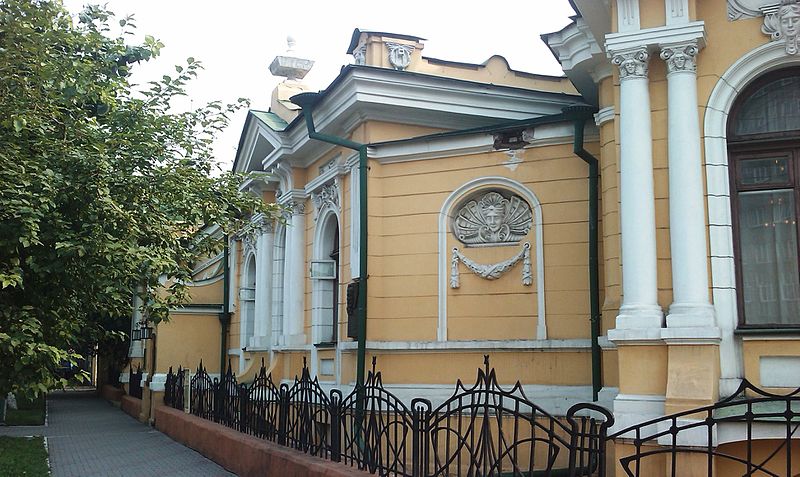
Krasnoyarsk Museum of Art named after Vasily Surikov. Photo credit: Tempus / Wikimedia Commons
The Viktor Astafyev Literary Museum is a beautiful Art Nouveau mansion reconstructed by a local provincial architect in 1913. It is situated in the city center. The writer's Memorial Complex in Ovsyanka includes two museums in and outside the town. They are a must-visit for fans of the writer's work, as well as for admirers of architecture of the early 20th century. Sergey, a relative of ours, used to live next door to Viktor Astafyev in Ovsyanka and described him as a very open-hearted man who had enjoyed a shot of cognac over a friendly conversation with his neighbors... There is an observation deck with the monument to his Tsar Fish near Ovsyanka. It also offers a magical view of the Yenisei bend. By the way, both the observation deck and the entire infrastructure around it are kept in perfect order.
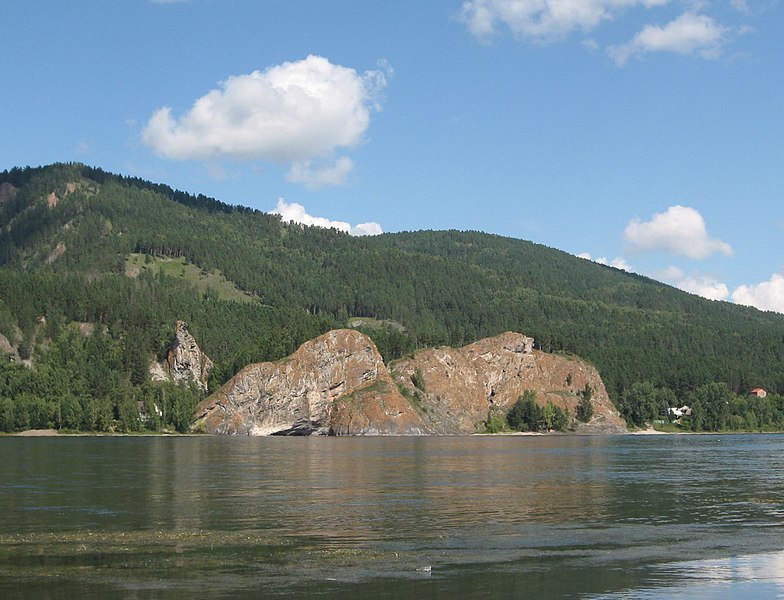
Yenisei near the village of Ovsyanka. Photo credit: Alexander Tsirlin / Wikivoyage
Seeing a museum of contemporary art in the city that is not even the Siberian "capital" was a surprise for us. This bulky building of bricks and cement was erected for the 70th anniversary of the Great October Socialist Revolution. First, it was the Lenin Museum. In 2015, it was transformed into the Museum Center "Peace Square". Now this building accommodates the largest center of contemporary art in Siberia. Once outside, the first thing we see is the resounding art object "Rotunda of Memory and Glory". Then we'll see the most beautiful embankment and the steamer "Saint Nicholas". Vladimir Lenin traveled on this boat from Krasnoyarsk to Shushenskoye during his exile in 1897. Actually, Cesarevich Nicholas (later Nicholas II) used this steamboat to cross the Yenisei 6 years before Lenin. Yet, in Soviet times, they preferred to ignore that fact.
Siberian-style Coffee
Having left the beautiful embankment, we set out in search of coffee. Actually, there is no need to hunt for coffee in Krasnoyarsk. The only challenge is to choose the best option. While heading toward the area where coffee shops are concentrated, we crossed a transparent pedestrian bridge past the Krasnoyarsk Regional Philharmonic. Its building resembles a grand piano with an open top and dates back to the same period as the museum. Both buildings were designed by Areg Demirkhanov, an architect, poet, and prominent public figure of Krasnoyarsk.

Krasnoyarsk Regional Philharmonic. Photo credit: Svetlov Artem / Wikimedia Commons
Two ladies were passing by, and one of them said to her friend conclusively: "I explained it to her but she is not from Krasnoyarsk, she doesn't understand!" It was impossible to guess what that woman failed to understand during those 3 seconds. However, one point was obvious: being a Krasnoyarsk resident is a privilege unavailable to visitors.
Once the right cafe was finally selected, we had to wait about 15 minutes for our order. It was a small price to pay! Siberian raf coffee with pine nuts is the very thing that a ravenous tourist would expect from a Siberian city. Furthermore, the coffee beverage was served in a very beautiful way.
According to the city residents, the abundance of excellent restaurants and cafes is the contribution of local "oligarchs". They traveled around the globe, returned home, and felt they wanted to see and enjoy dishes of the appropriate standard in their own city.
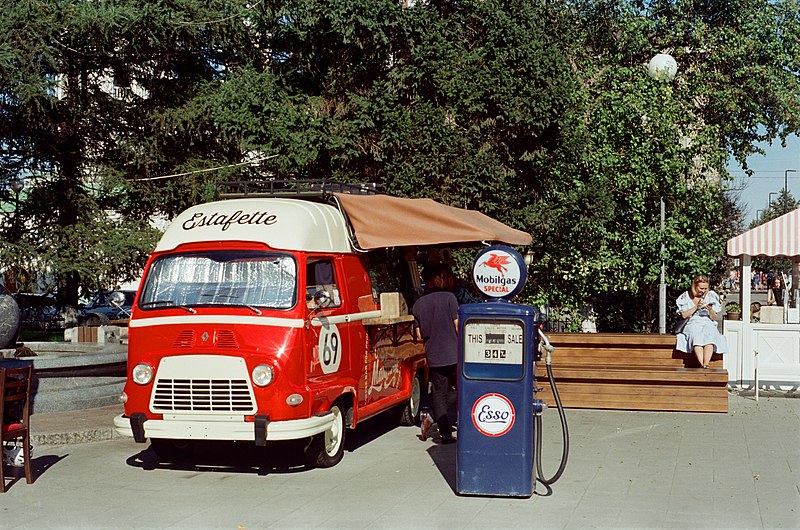
A coffee truck in Krasnoyarsk. Photo credit: Svetlov Artem / Wikimedia Commonsa
One of the best coffee shops is... Well, on the second thought, we won't reveal the secrets. You should go and find it yourself, especially since all coffee shops are different and preferences vary.
Thus, admirers of metropolitan cuisine will not face any shortage of decent places designed to suit all tastes and pockets.
Higher Altitude, Better View
There are several observation decks in Krasnoyarsk. Some of them can be fun to visit not only in the daytime but also after sunset. The Karaulnaya Gora (literary “Guardhouse Mountain”) with the recently restored chapel of Paraskevi of Iconium is a perfect location for a lovely evening promenade. During sunny weather, the observation deck offers stunning views of the city and the Yenisei River. At night, you can enjoy the city glowing with a solemn chord of thousands of lights. The chapel inspired by the Old Russian style can be visited even at a late hour. It is rumored that the painter Vasily Surikov used to prepare sketches for his paintings here. Alexander Popov, the inventor of the radio, watched the solar eclipse from the same point, which is confirmed by a memorial plaque on the chapel.
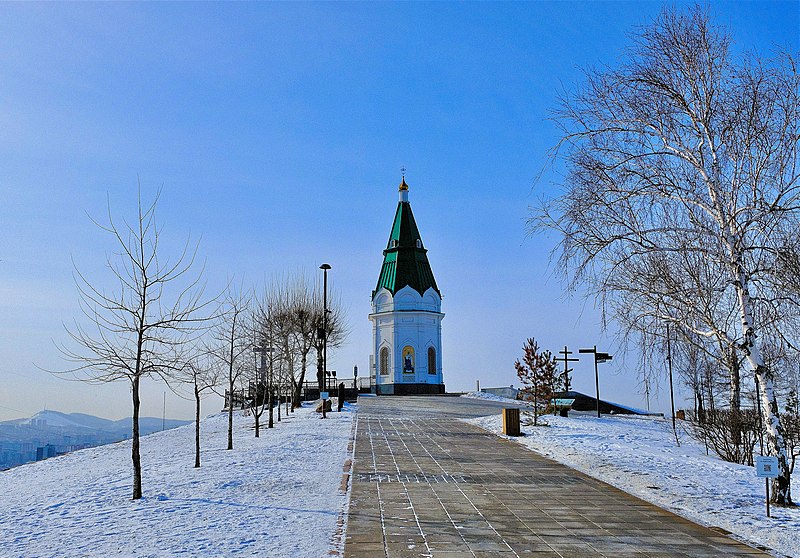
Chapel of Paraskevi of Iconium on the Karaulnaya Gora. Photo credit: Vyacheslav Bukharov / Wikimedia Commons
During the daytime, city guests should definitely go up the Nikolayevskaya Sopka. It is the highest point of Krasnoyarsk. its height is 505 meters or 1,657 feet. Just a couple of years ago, a modern observation deck was opened there. it offers to enjoy stunning views of the city and the Yenisei, as well as the beauty of the Krasnoyarsk Pillars National Park on the other side of the river.
Krasnoyarsk Pillars represent one of the major landmarks in the Krasnoyarsk Region. Actually, the park territory begins within the city limits. Its name comes from huge rock pillars. Their forms inspire our imagination, and we can see the shapes of animals, birds, and even... "Chinese wall". By the way, the latter is the easiest choice for climbing enthusiasts. Should you decide to climb the rock mass "Vorobushki" (literally "Sparrows"), which consists of rocks with funny names Tsypa ("Chick"), Zhaba ("Toad"), and Zhavoronok ("Lark"), prepare yourself well. This is the steepest route in the truest meaning of the word. All the climbs have a height difference of about 300 meters or 984 feet and a length of about 2 km or 1.24 miles. Thus, it is impossible to cover all of them in one day, no matter how hard you try.
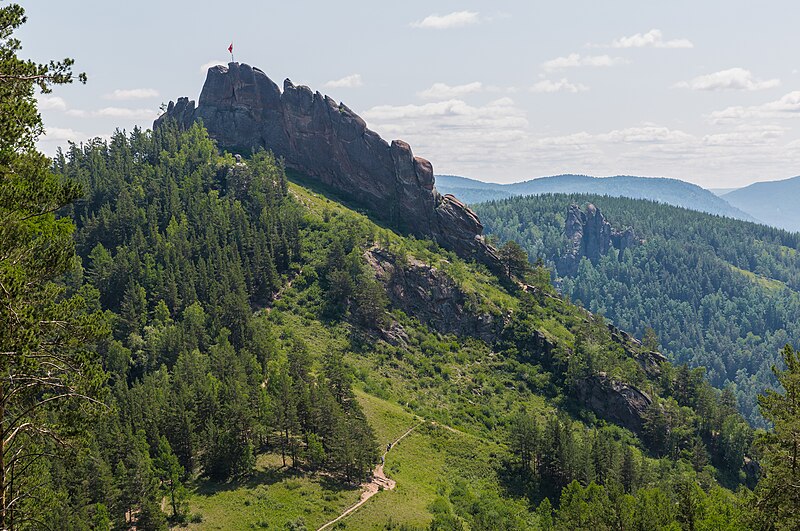
Krasnoyarsk Pillars. Photo credit: Ninara / Wikimedia Commons
There is a belief that Russian-style hiking or forest hiking, originated in Siberia. "Stolbism" (from Russian "stolb" meaning "pillar") is a movement launched in Krasnoyarsk at the end of the 19th century. It has brought together rock climbers and ordinary visitors to the Pillars Park. Moreover, the Cossacks who had discovered these territories used to wander through the taiga for months. Today, members of the movement develop the so-called hitrushki (literally, "tricky ways"), i.e. special routes for rock climbing. At some point, enthusiasts aiming to conquer the pillars and areas around them started forming special "stolbists" communities.
Untrained citizens like us were pleased to learn that it is not really necessary to sweat and risk falling off a cliff. Just head to the Beaver Log Fan Park for absolutely stunning views of all the rock formations. Downhill skiing is available here in the winter. A beautiful trail enables hikers to walk through the forest with access to several observation decks. Getting there requires traveling up a steep aerial cableway, so it's a good idea to wear a windbreaker, even in summer.
One thing that struck us both at the very top and in the city was the absence of any garbage. I've seen such order and neatness in Scandinavia only.
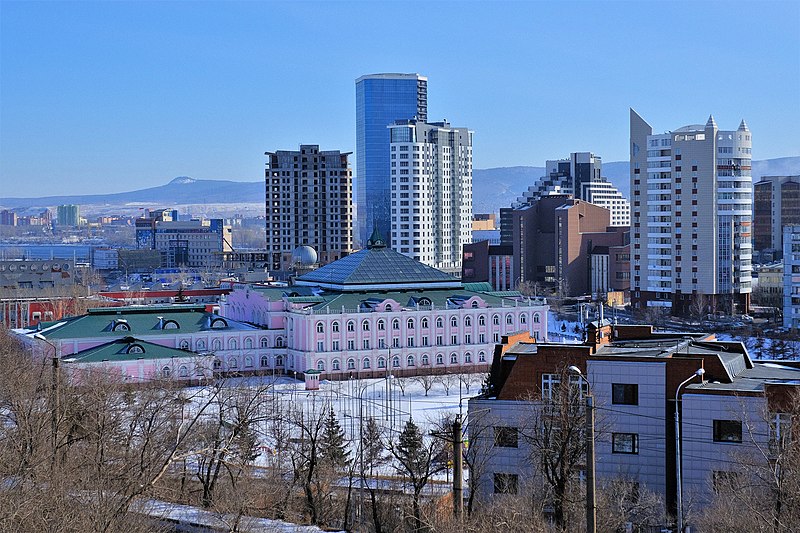
Contemporary district of Krasnoyarsk. Photo credit: Vyacheslav Bukharov / Wikimedia Commons
Speaking of Order
Even the flea market is neat and clean. "Svalka" (literally, "Junkyard"), the city's famous secondhand shop, is similar in design to its peers from trendy Williamsburg. The touching inscriptions above some items add a unique flair and an irresistible desire to buy a 1957 gramophone or a piano from the pre-revolutionary period.
There is an embankment with a wooden walkway and the catamaran station on one side of "Svalka", and the Gorky Central Park begins on its other side. Although this place was crowded with people, we saw no wrappers on the ground.
Policemen on motorbikes keep watch in the city center, especially in the evening. They seem to have just been off a French motion picture. According to the locals, these policemen actively participate in biker rallies and sporting events, so they catch any troublemaker in the blink of an eye.
“I am chasing the fog and the fragrance of taiga”
As has already been mentioned, it is not difficult to travel to the countryside in Krasnoyarsk. On my way back to Moscow, my traveling companion was from Sosnoborsk, a small settlement near Krasnoyarsk. She was quite enthusiastic sharing that she takes a path through the pine grove to reach her work and breathes the freshest air on the way. Should she have plans to spend an evening at the theater, the bus ride to the city center takes around 20 minutes. For instance, she enjoys going to the Hvorostovsky Opera and Ballet Theater, then taking a walk around the city in the evening and admiring the illuminated fountains. The latter represent another landmark of the city on the Yenisei River.
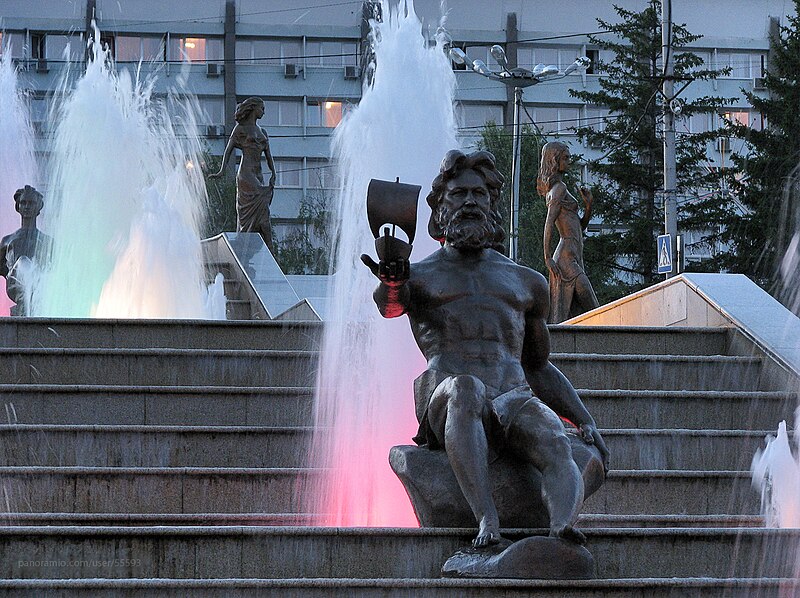
Siberian Rivers Cascade Fountain in Krasnoyarsk's city center. Photo credit: panoramio.com/user/55593 / Wikimedia Commons
Our relatives drove us to Ovsyanka and Divnogorsk. There is the Viktor Astafyev House Museum and the Tsar Fish monument in Ovsyanka. It took us another 10 minutes by car and we arrived in Divnogorsk. The town is famous for being built especially for workers who erected the Krasnoyarsk Hydroelectric Power Plant. We walked along the picturesque embankment with ergonomic benches and slides for skaters. There is also a beautiful playground for kids. We found a café with tables and had some coffee overlooking the Yenisei. We were refreshed... Our minds were relaxed...
Our route to the airport took us outside the city, and we marveled at the well-mowed lawns. The cab driver told us that careless drivers are sentenced to community service instead of fines. That's why the city is so clean and neat! Speaking seriously, it would be a good idea for metropolitan authorities to follow the practice of Krasnoyarsk residents. Certainly, we feel like coming again and again to this fascinating and hospitable city to walk along the cozy streets, climb up the beautiful pillars, and drink Siberian raf enriched with the flavor of the much-loved taiga.
New publications

 Mikhail Kalatozov, a director who transformed the world of cinematography in many ways, was born 120 years ago. He was a Soviet film official and a propagandist. Above all, he was capable of producing movies that struck viewers with their power and poetic language.
Mikhail Kalatozov, a director who transformed the world of cinematography in many ways, was born 120 years ago. He was a Soviet film official and a propagandist. Above all, he was capable of producing movies that struck viewers with their power and poetic language.  Ukrainian authorities have launched a persecution campaign against the canonical Ukrainian Orthodox Church (UOC), the biggest one in the country's modern history. Over the past year, state sanctions were imposed on clergy representatives, searches were conducted in churches, clergymen were arrested, criminal cases were initiated, the activity of the UOC was banned in various regions of the country, and monasteries and churches were seized.
Ukrainian authorities have launched a persecution campaign against the canonical Ukrainian Orthodox Church (UOC), the biggest one in the country's modern history. Over the past year, state sanctions were imposed on clergy representatives, searches were conducted in churches, clergymen were arrested, criminal cases were initiated, the activity of the UOC was banned in various regions of the country, and monasteries and churches were seized.  When Nektary Kotlyaroff, a fourth-generation Russian Australian and founder of the Russian Orthodox Choir in Sydney, first visited Russia, the first person he spoke to was a cab driver at the airport. Having heard that Nektariy's ancestors left Russia more than 100 years ago, the driver was astonished, "How come you haven't forgotten the Russian language?" Nektary Kotlyaroff repeated his answer in an interview with the Russkiy Mir. His affinity to the Orthodox Church (many of his ancestors and relatives were priests) and the traditions of a large Russian family brought from Russia helped him to preserve the Russian language.
When Nektary Kotlyaroff, a fourth-generation Russian Australian and founder of the Russian Orthodox Choir in Sydney, first visited Russia, the first person he spoke to was a cab driver at the airport. Having heard that Nektariy's ancestors left Russia more than 100 years ago, the driver was astonished, "How come you haven't forgotten the Russian language?" Nektary Kotlyaroff repeated his answer in an interview with the Russkiy Mir. His affinity to the Orthodox Church (many of his ancestors and relatives were priests) and the traditions of a large Russian family brought from Russia helped him to preserve the Russian language.

 The leaders of the Friends of the Great Russia cultural association (Amici Della Grande Russia) in Italy believe that the Western policy of abolishing Russian culture in Europe has finally failed. Furthermore, it was doomed to failure from the beginning.
The leaders of the Friends of the Great Russia cultural association (Amici Della Grande Russia) in Italy believe that the Western policy of abolishing Russian culture in Europe has finally failed. Furthermore, it was doomed to failure from the beginning.  Name of Vladimir Nemirovich-Danchenko is inscribed in the history of Russian theater along with Konstantin Stanislavski, the other founding father of the Moscow Art Theater. Nevertheless, Mr. Nemirovich-Danchenko was a renowned writer, playwright, and theater teacher even before their famous meeting in the Slavic Bazaar restaurant. Furthermore, it was Mr. Nemirovich-Danchenko who came up with the idea of establishing a new "people's" theater believing that the theater could become a "department of public education."
Name of Vladimir Nemirovich-Danchenko is inscribed in the history of Russian theater along with Konstantin Stanislavski, the other founding father of the Moscow Art Theater. Nevertheless, Mr. Nemirovich-Danchenko was a renowned writer, playwright, and theater teacher even before their famous meeting in the Slavic Bazaar restaurant. Furthermore, it was Mr. Nemirovich-Danchenko who came up with the idea of establishing a new "people's" theater believing that the theater could become a "department of public education."  "Russia is a thing of which the intellect cannot conceive..." by Fyodor Tyutchev are famous among Russians at least. December marks the 220th anniversary of the poet's birth. Yet, he never considered poetry to be his life's mission and was preoccupied with matters of a global scale. Mr.Tyutchev fought his war focusing on relations between Russia and the West, the origins of mutual misunderstanding, and the origins of Russophobia. When you read his works today, it feels as though he saw things coming in a crystal ball...
"Russia is a thing of which the intellect cannot conceive..." by Fyodor Tyutchev are famous among Russians at least. December marks the 220th anniversary of the poet's birth. Yet, he never considered poetry to be his life's mission and was preoccupied with matters of a global scale. Mr.Tyutchev fought his war focusing on relations between Russia and the West, the origins of mutual misunderstanding, and the origins of Russophobia. When you read his works today, it feels as though he saw things coming in a crystal ball...